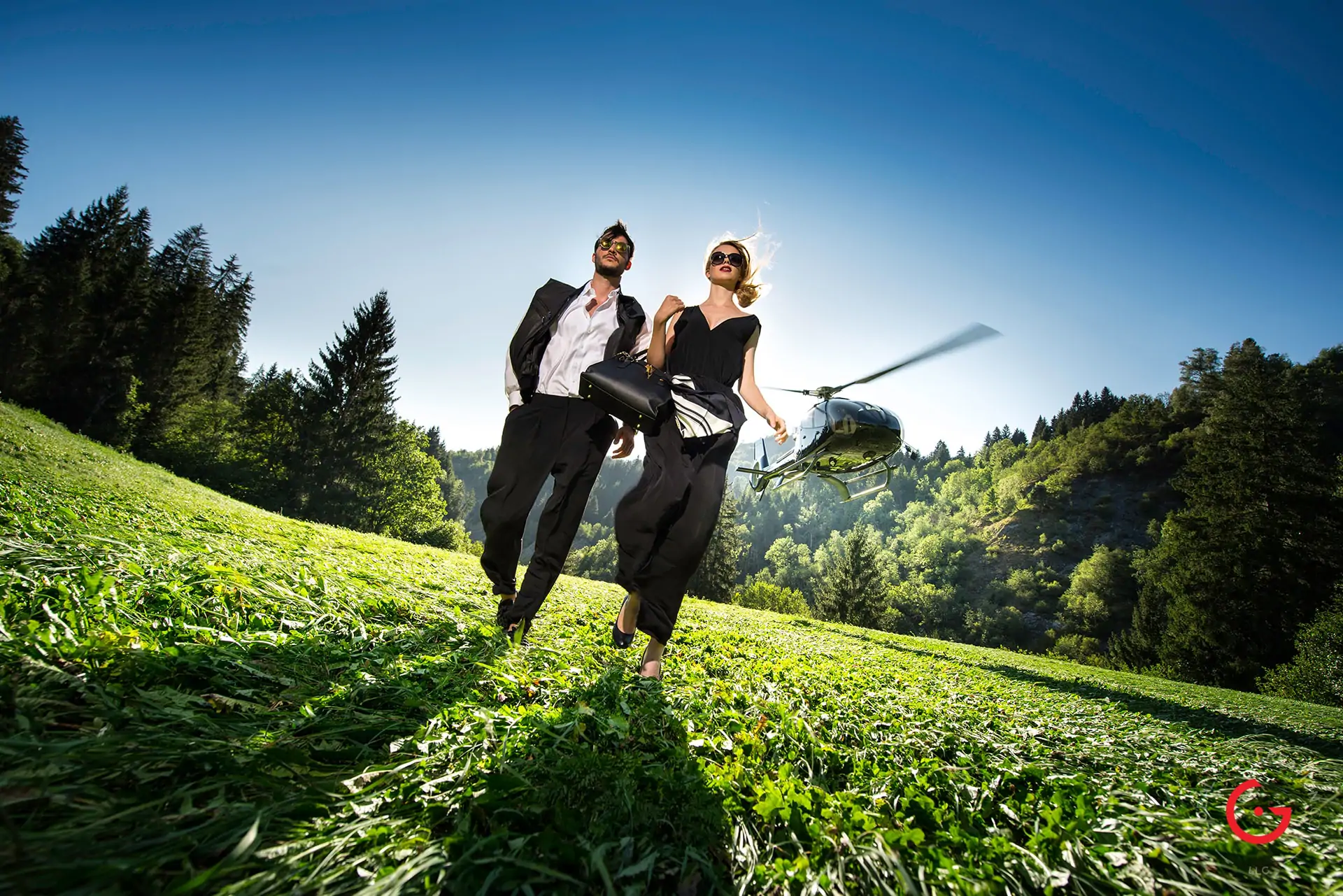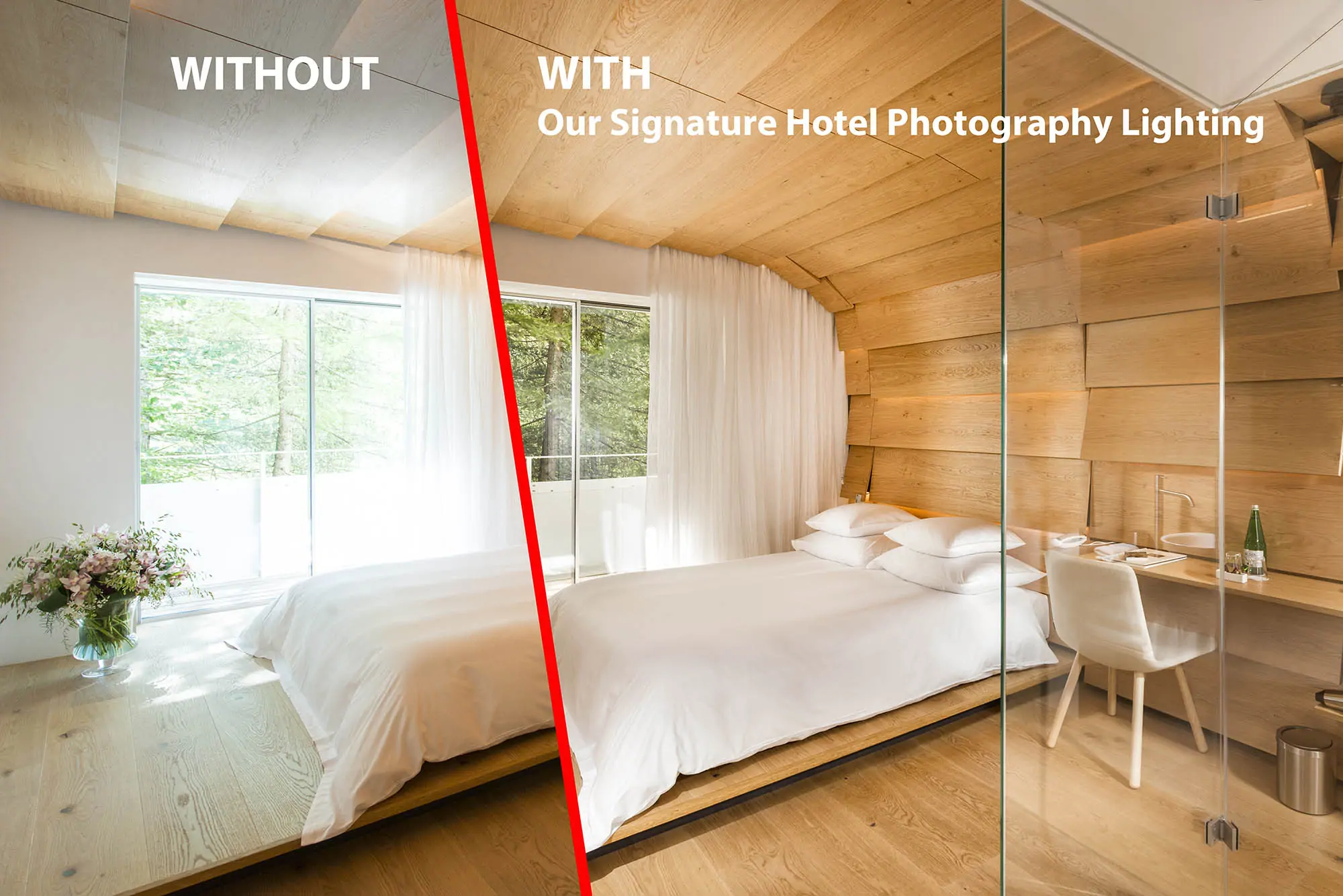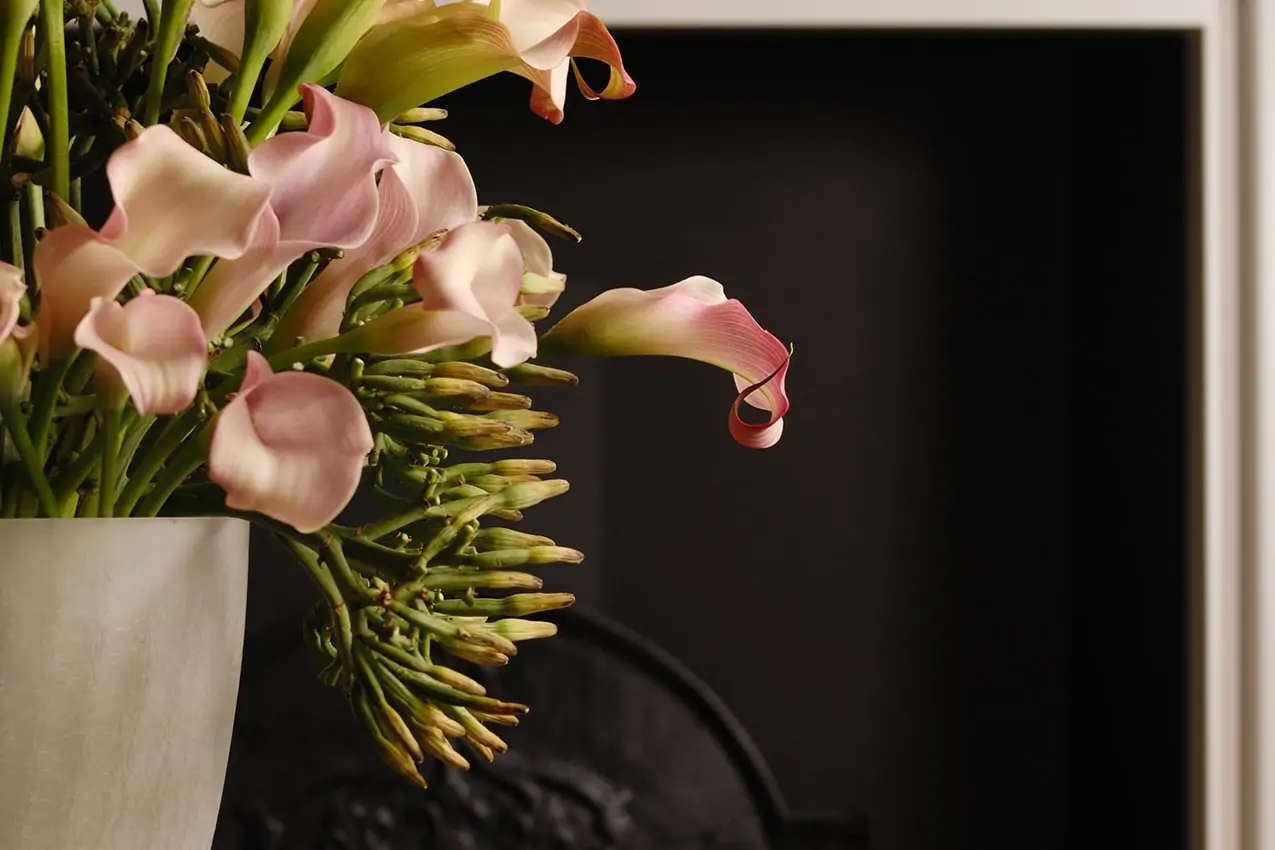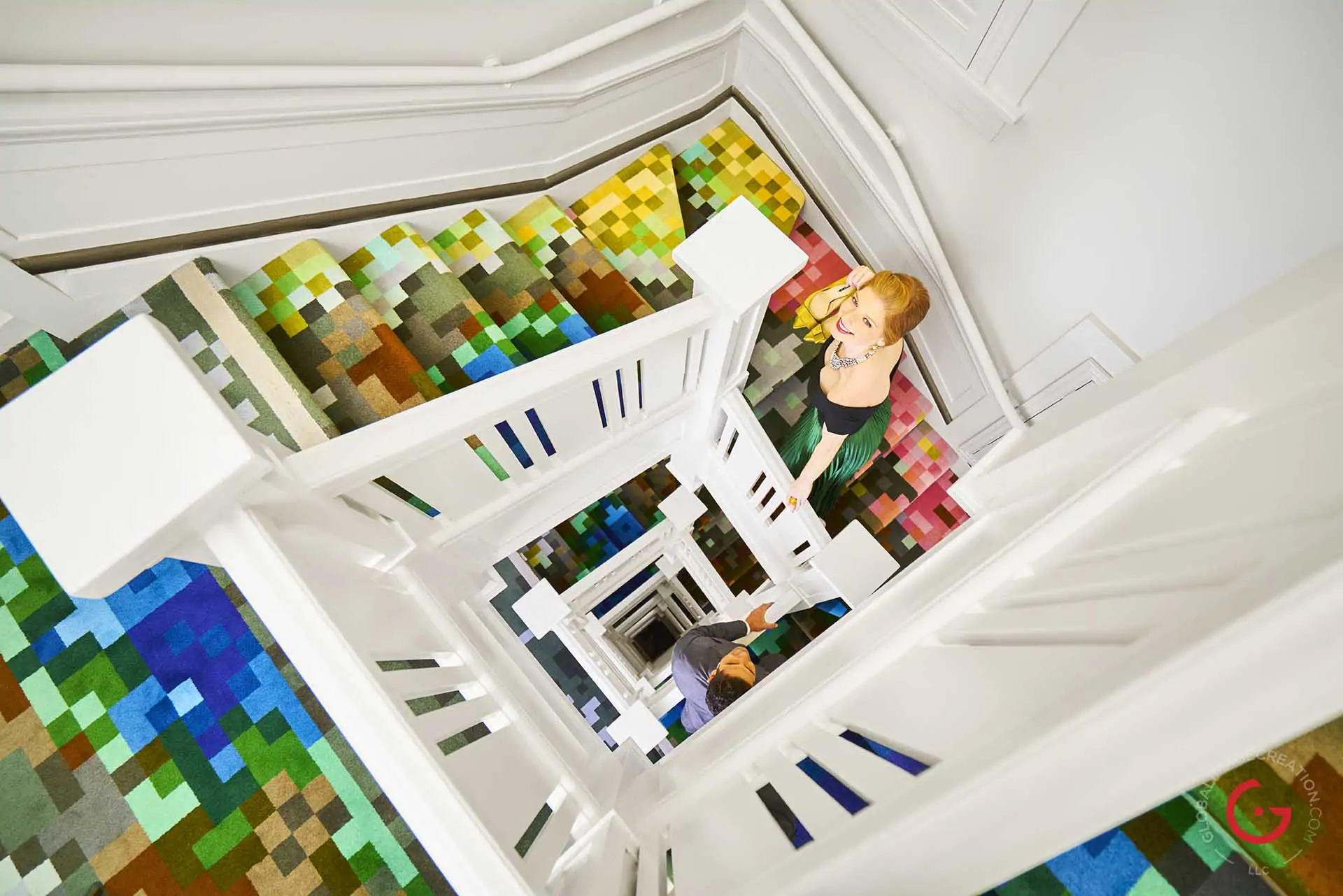Your Guide to Planning a Great Hotel Photoshoot
Is it crazy to ask that a hotel photoshoot be fun, creative, engaging, and produce a great return on investment? Not at all. However, it might be a little crazy to ask for all of that without putting time and effort into the planning stages, and without ensuring that you’ve got the right photographer for the job. In the well-known words of Winston Churchill and/or Benjamin Franklin and/or that inspirational poster in your old manager’s office: “if you’re failing to plan, you’re planning to fail”.
Find our Updated Guide to Planning a Hotel Photoshoot here.
In this article, we’re breaking down the six phases of a hotel photoshoot, so you can plan to get the most out of your shoot. This guide is for you if you want to:
-
Maximize your time and budget
-
Ensure your photographer has the capabilities you need (shooting sushi is different than shooting a sunset, and architecture is not the same as your room interiors)
-
Receive exactly the images you need, when you need them, and in the format you need
-
As well as flag and address any potential problems early in the process.
If you prefer the excitement of last minute changes, potentially wasting money, and possibly finding yourself with a whole load of photos you can’t use, this guide likely isn’t for you, but we bet you’ve got some great stories we’d love to hear. 🙂
This piece is the first part of a larger guide to The Six Phases of a Hotel Photoshoot. You will also want to see Phase One: Establishing Your hotel photography needs. Phase Two: 10 Questions to Ask Before You Hire a Hotel Photographer

Download these free guides to help you thru every step of the process of planning your hotel photoshoot:
The Six Phases of a Hotel Photoshoot
Just about every hotel photoshoot shoot can be broken down into six basic phases. Of course, some shoots are more complex than others, but most can be organized using these categories:
-
Establish your photography & media needs
-
Find and hire your photographer
-
Plan your photoshoot
-
The shoot
-
Editing and post-production
-
Leverage your media
Below, we’ve highlighted what each stage is, why it’s important, and how to get it done. Download our checklist to help guide you in planning a successful shoot.
Establish Your Hotel Photography & Media Needs
Have a look at the full article on: Establishing Your Photography & Media Needs.
What: This stage is all about taking the time to give some thought to your hotel’s photography needs. For example, is your website designer struggling to find hero images that fit the website? Or, is the graphic designer stuck with photos that won’t work well for the printed pieces they need to create? Do you find that you have hundreds of images in your company’s shared drive, but hardly any seem right?
Establishing needs is one of the most important stages of the planning process, and will help ensure that your shoot meets the needs of your organization and that you get the best return on investment (ROI) possible. This stage will help guide every other decision you make, so it’s definitely worth doing properly.
Why: Without giving careful thought to your hotel’s needs early in the process, you might end up hiring a photographer who doesn’t suit the work, as well as miss opportunities to capture media. Your shoot could end up being too targeted, limiting your ROI; or too unstructured, and fail to meet your actual needs; or just chaotic and disorganized.
How: Draft a list of images (and other media) you want, where media will be used, and what category it falls into (e.g. architecture, conceptual, destination, food/restaurant, hotel, interior, lifestyle). In this stage you should also make sure you’re talking to other people and departments at your hotel about their photography or video needs, and looking for opportunities to use media from the same shoot across multiple channels.
Take a look at Phase One of a Hotel Photoshoot: Establishing Your Photography & Media Needs for a breakdown of each stage of this process, and a downloadable template can use for guidance.
What does your image say? Global Image Creation is a top hotel photographer for some of the world’s best rated hotels. How can we work together?
Find and Hire a Hotel Photographer
Have a look at the full article on Phase Two of a Hotel Photoshoot: 10 Questions to Ask Before You Hire a Photographer
What: Finding the right hotel photographer is about more than style, availability, and budget, so before you decide whose hands to put your shoot into, make sure you’ve asked all the right questions. For example, in what aspect ratio do you need your images composed in? Will they be optimized for different channels? Does the photographer have experience shooting in the different categories you need? How involved will you be in the shoot itself? When will they deliver the images and what rights will you have to use them?
Why: Taking the time to find the right partner now, and ensuring that they can meet all of your needs on time and within budget, will save you a lot of time and a lot of aspirin down the road.
How: Use our Phase Two of a Hotel Photoshoot: 10 Questions to Ask Before You Hire a Photographer to help you through the process of shortlisting and selecting the perfect photographer for your shoot.
Plan Your Hotel Photoshoot
What: Once you’ve selected your photographer, this stage is all about working together to ensure the photoshoot suits all of your needs. This stage will include steps like:
-
Creating a detailed shot lists and call sheets.
-
Identifying and hiring any additional services for the shoot, including models, wardrobe, make-up artists, and other specializations.
-
Establishing your point person to work with the photographer on the day(s) of the shoot.
-
Looking for opportunities to capture additional media and leverage the shoot itself for marketing (e.g behind-the-scenes Instagram stories).
-
Familiarizing your photographer with your hotel and what makes it unique
-
Establishing a plan B for parts of the shoot that depend on factors out of your control, such as weather.
-
Finalizing the details of the shoot itself, including reserving necessary rooms and setup areas.
-
Setting the schedule (including gaps that allow for any changes and some impromptu shoot ideas).
-
Alerting support staff.
-
Setting deadlines for delivery of media, and expectations for the editing and post-production process.
Why: A hotel photoshoot is unlikely to go 100% to plan, which is absolutely fine, and some flexibility should definitely be allowed for in your schedule. However, the more you can have arranged in advance, and the fewer decisions that have to be made on the day, the smoother the day will go. Any details that can be sorted in advance will mean more time spent actually shooting. This stage will also ensure that you are able to communicate the important details about your brand and property. Taking the time to share the stories and nuances that set you apart will mean a better shoot and better photos.
How: This stage is about having open discussions with your photographer about the details of the shoot itself. Your photographer should be able to guide these conversations (which makes sense, since photoshoots are a huge part of their job and a small part of yours!), however if there is anything you feel hasn’t been addressed you should be sure to bring it up now.
One thing you should definitely discuss are any details of the shoot that you’re not certain you can guarantee. There might be rooms you aren’t sure will be available to shoot, or renovations that are suddenly taking longer than planned, or the possibility of two weeks of rainy weather. Any experienced hotel photographer will understand and can work with you to adjust your schedule. Having your contingency plans in place where possible will help you make the most of your shoot.
Get Your Shots
What: If you’ve done all of your planning and hired the right photographer, then this is the fun bit. A great hotel photoshoot is still a lot of work, but it is creative, engaging, and exciting work.
Why: Well, after all the time you put into planning the shoot and hiring the photographer, it would be a real shame not to do the shoot!
How: The process of the photoshoot itself, and how involved you’ll be, will depend a lot on your availability and how your photographer works. For example, we work in-camera using specialized lighting techniques, so our clients can see the photo come together as we craft it (on an iPad, not on the camera’s tiny screen), make adjustments, and give initial approvals. This means that our photoshoots can be very collaborative, our clients have the opportunity to help shape the photos during the shoot and see what they will look like while there is still time to make adjustments.
Your photographer may prefer to use natural light or rely on post-processing techniques to create the final image off site, which will limit your involvement in getting to preview images (find out out more about how different photographers work in Phase Two of a Hotel Photoshoot: 10 Questions to Ask Before You Hire a Photographer). However, with an experienced photographer, the photoshoot should still be a collaborative and engaging experience, and when the photographer leaves you should feel comfortable knowing you have the images you need.

Editing and Post-Production
What: Following the shoot itself, your photographer will make edits and final touches to your photos or other media before they’re delivered. Editing and delivery can vary greatly, so be sure you are clear on what to expect.
Why: This is the stage where your photographer turns each image into a polished, usable photo that perfectly reflects your brand (and the alternative is being handed a hard-drive of giant, unedited RAW images at the end of a shoot). While we personally believe that photographers should not rely too much on post-production, they need to be totally fluent in post to be able to make any needed edits to finish the images and make them feel like the actual place you want to convey. Items that any photographer should be able to take care of include color, contrast, and perspective adjustments; as well as removing unwanted details like background distractions; and even swapping a cloudy view from the room’s window to one taken later that reflects your normal clear, sunny vista.
How: This process depends on how your photographer works. For example, if your photographer uses relies heavily on post-processing techniques such as High Dynamic Range (HDR) this process will take a lot longer and be more involved than a photographer who shoots in-camera. If your photographer doesn’t work in-camera, you might also find that you have to pay for additional editing time to remove or change things you didn’t notice on the day of the shoot (for example, you might notice a pillow in the wrong place, or a vase that needs to be removed). If your photographer ‘batch edits’ (makes automated corrections to all of the photos at once) and provides all the images they shot, you might receive hundreds of photos within a few days, but each photo won’t have received individual attention needed to really make them stunning, and you’ll have to spend hours looking through all the images to find the ones you can use.
Before you book your photographer you’ll want to get a good idea of their editing and post-production process. Make sure that your photographer is aware of any deadlines as well as how you’re planning to use the images, and is happy to deliver photos ready for use within your timeframe. If you have any special requests, these should be raised early in the planning process. For example, if there’s a few photos you would like delivered the day after the shoot, your photographer will be able to work a few hours of editing time into the shooting schedule as long as you ask during the planning stage. It is a lot harder, however, to turn pictures around in a night with no notice after a packed day of shooting.
Use and Leverage Your Media
What: This is the stage that you get to share the results of all your hard work with the world, and it feels so good. The moment you first receive those photos your brain will be spinning with all of the possibilities. However, once those photos are tucked away in a folder on your computer, and the next project comes along to demand your attention, it can be easy to miss opportunities to fully leverage the media you’ve worked so hard to create.
We believe it’s worth making a plan to ensure sure you’re leveraging your new media and getting the highest ROI possible.
Why: Well, the photos aren’t doing you any good sitting in the “Winter Photoshoot 2019” folder on your hotel’s shared drive, and even if you’ve used the photos for their original purpose you can always look for opportunities to get more value. Using the same images for multiple purposes and channels will give you a better ROI on the media you produced, present a more cohesive brand image and build familiarity, and could even help with budgeting and organizing future shoots.
How: The more use you can get from each image, the more valuable it is to your hotel. We recommend ask yourself questions like:
-
During the planning stages of the shoot, did you check with other people at your hotel to see what their photo needs were? If so, have you made sure to send those images to the right people?
-
Have you used the images for the original purposes that you identified in your shot list?
-
If you have a brand center that hosts images, have you uploaded the files there?
-
Have you looked for opportunities to use the same image across multiple channels and platforms?
-
Have you integrated possibilities for future use of the images into your communications and marketing plan?
-
Have you created guidelines for using the images that you can share internally and externally as needed?
-
Have you notified everyone at your hotel (e.g. graphic designers, internal communications, social media team) that the photos are available for use?
-
Have you notified any external agencies you work with (such as your PR or marketing agency) that you have new photos available for use?
-
Have you labelled and organized the images so that they can be easily found later?
Hopefully, this article will help you get the most out of your next hotel photoshoot. Don’t forget to check out the rest of the articles in this series for more in-depth information, including:
Phase One of a Hotel Photoshoot: Establish Your Hotel Photography Needs
Phase Two of a Hotel Photoshoot: 10 Questions to Ask Before You Hire a Hotel Photographer
It’s Easy To Say Hello
Thanks reading to the end of this page. It seems like you might have an interest in our photography and video production services. You might just have some questions or perhaps you just want to say hello. If you are reading this, we would love to hear from you. Please send us a note using this form.

Related Posts
February 28, 2019
Establishing Your Hotel Photography Needs
December 24, 2023
What Does a Hotel Photographer Do?
February 28, 2019



